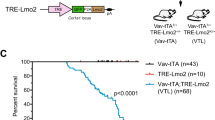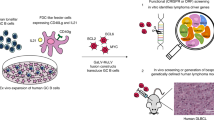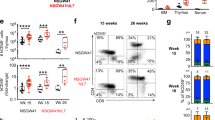Abstract
We have established a panel of nine immortal cell lines from T cell malignancies which arose in mice transgenic for the SCL and LMO1 genes. Cells from the primary malignancies initially grew very slowly in vitro, loosely attached to a stromal layer, before gaining the ability to proliferate independently. Upon gaining the ability to proliferate in the absence of a stromal layer, these cell lines grew rapidly, doubling every 14–23 h, to a very high density, approaching 107 cells/ml. Whereas the tumors which arise in SCL/LMO1 double transgenic mice are typically diploid or pseudodiploid, the cell lines were all grossly aneuploid, suggesting the possibility that additional genetic events were selected for in vitro. Given that SCL and LMO1 gene activation are both commonly seen in human patients with T cell acute lymphoblastic leukemia, these cell lines may be a useful in vitro model for the human disease.
This is a preview of subscription content, access via your institution
Access options
Subscribe to this journal
Receive 12 print issues and online access
$259.00 per year
only $21.58 per issue
Buy this article
- Purchase on Springer Link
- Instant access to full article PDF
Prices may be subject to local taxes which are calculated during checkout


Similar content being viewed by others
References
Moore G, Minowada J . Human hematopoietic cell lines: a progress report In Vitro 1969 4: 100–114
Drexler HG, Matsuo Y . Guidelines for the characterization and publication of human malignant hemotopoietic cell lines Leukemia 1999 13: 835–842
Drexler HG, Dirks WG, MacLeod RA . False human hematopoietic cell lines: cross-contaminations and misinterpretations Leukemia 1999 13: 1601–1607
Bash RO, Hall S, Timons CF, Crist WM, Amylon M, Smith RG, Baer R . Does activation of the TAL1 gene occur in a majority of patients with T-cell acute lymphoblastic leukemia? A Pediatric Oncology Group study Blood 1995 86: 666–676
Boehm T, Foroni L, Kaneko Y, Perutz MF, Rabbitts TH . The rhombotin family of cysteine-rich LIM-domain oncogenes: distinct members are involved in T-cell translocations to human chromosomes 11p15 and 11p13 Proc Natl Acad Sci USA 1991 88: 4367–4371
Larson RC, Osada H, Larson TA, Lavenir I, Rabbitts TH . The oncogenic LIM protein Rbtn2 causes thymic developmental aberrations that precede malignancy in transgenic mice Oncogene 1995 11: 853–862
Larson RC, Lavenir I, Larson TA, Baer R, Warren AJ, Wadman I, Nottage K, Rabbitts TH . Protein dimerization between Lmo2 (Rbtn2) and Tal1 alters thymocyte development and potentiates T cell tumorigenesis in transgenic mice EMBO J 1996 15: 1021–1027
Aplan PD, Jones CA, Chervinsky DS, Zhao X, Ellsworth M, Wu C, McGuire EA, Gross KW . An scl gene product lacking the transactivation domain induces boy abnormalities and cooperates with LMO1 to generate T-cell malignancies in transgenic mice EMBO J 1997 16: 2408–2419
Chervinsky DS, Zhao XF, Lam DH, Ellsworth M, Gross KW, Aplan PD . Disordered T-cell development and T-cell malignancies in SCL LMO1 double-transgenic mice: parallels with E2A-deficient mice Mol Cell Biol 1999 19: 5025–5035
Bain G, Engel I, Robanus Maandag EC, te Riele HP; Voland JR, Sharp LI, Chun J, Huey B, Pinkel D, Murre C . E2A deficiency leads to abnormalities in alpha-beta T-cell development and to rapid development of T-cell lymphomas Mol Cell Biol 1997 17: 4782–4791
Hsu HL, Wadman I, Tsan JT, Baer R . Positive and negative transcriptional control by the TAL1 helix–loop–helix protein Proc Nat Acad Sci USA 1994 91: 5947–5951
Park ST, Sun XH . The Tal1 oncoprotein inhibits E47-mediated transcription – mechanism of inhibition J Biol Chem 1998 273: 7030–7037
Voronova AF, Lee F . The E2A and tal-1 helix–loop–helix proteins associate in vivo and are modulated by Id proteins during interleukin 6-induced myeloid differentiation Proc Natl Acad Sci USA 1994 91: 5952–5956
Yan W, Young AZ, Soares VC, Kelley R, Benezra R, Zhuang Y . High incidence of T-cell tumors in E2A-null mice and E2A/Id1 double-knockout mice Mol Cell Biol 1997 17: 7317–7327
Aplan PD, Begley CG, Bertness V, Nussmeier M, Ezquerra A, Coligan J, Kirsch IR . The SCL gene is formed from a transcriptionally complex locus Mol Cell Biol 1990 10: 6426–6435
McGuire EA, Rintoul CE, Sclar GM, Korsmeyer SJ . Thymic overexpression of Ttg-1 in transgenic mice results in T-ceell acute lymphoblastic leukemia/lymphoma Mol Cell Biol 1992 12: 4186–4196
Collazo-Garcia N, Scherer P, Aplan PD . Cloning and characterization of a murine SIL gene Genomics 1995 30: 506–513
McGuire EA, Hockett RD, Pollock KM, Bartholdi MF, O'Brien SJ, Korsmeyer SJ . The t(11;14)(p15;q11) in a T-cell acute lymphoblastic leukemia cell line activates multiple transcripts, including Ttg-1, a gene encoding a potential zinc finger protein Mol Cell Biol 1989 9: 2124–2132
Danska JS, Pflumio F, Williams CJ, Huner O, Dick JE, Guidos CJ . Rescue of T cell-specific V(D)J recombination in SCID mice by DNA-damaging agents Science 1994 266: 450–456
Felsher DW, Bishop JM . Reversible tumorigenesis by MYC in hematopoietic lineages Mol Cell 1999 4: 199–207
Adams JM, Harris AW, Strasser A, Ogilvy S, Cory S . Transgenic models of a lymphoid neoplasia and development of a pan-hematopoietic vector Oncogene 1999 18: 5268–5277
Hirama T, Koeffler HP . Role of the cyclin-dependent kinase inhibitors in the development of cancer Blood 1995 86: 841–854
Drexler HG . Review of alterations of the cyclin-dependent kinase inhibitor of INK4 family genes p15, p16, p18 and p19 in human leukemia lymphoma cells Leukemia 1998 12: 845–859
Acknowledgements
We would like to thank Drs Ken Gross, Warren Pear, Armelle Regnault and Ilan Kirsch for insightful discussions of these cell lines, the RPCI Biopolymer facility for DNA sequence analysis, and the RPCI Flow Cytometry facility for assistance with immunophenotype analysis. A portion of this work was supported by NIH grants CA16056 and CA6333 and a Leukemia Society of America Scholar grant to PDA.
Author information
Authors and Affiliations
Rights and permissions
About this article
Cite this article
Chervinsky, D., Lam, D., Zhao, XF. et al. Development and characterization of T cell leukemia cell lines established from SCL/LMO1 double transgenic mice. Leukemia 15, 141–147 (2001). https://doi.org/10.1038/sj.leu.2401997
Received:
Accepted:
Published:
Issue Date:
DOI: https://doi.org/10.1038/sj.leu.2401997
Keywords
This article is cited by
-
Mechanistic insights into chromatin targeting by leukemic NUP98-PHF23 fusion
Nature Communications (2020)
-
Molecular pathogenesis of T-cell leukaemia and lymphoma
Nature Reviews Immunology (2008)
-
Gene expression profiling of precursor T-cell lymphoblastic leukemia/lymphoma identifies oncogenic pathways that are potential therapeutic targets
Leukemia (2007)



